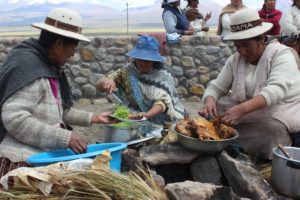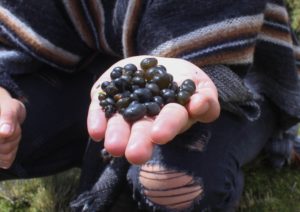Sajama, Bolivia, Apr 6 (EFE).- Medicinal herbs, edible algae and different techniques for cooking llama and alpaca meat are some of the culinary contributions of Bolivia’s Southern Altiplano region that have drawn the attention of both chefs and biologists, who are looking to generate new appreciation for these products and create menus that promote their sustainable consumption.
Chefs at the La Paz restaurants Gustu and Jardin de Asia and biologists from the New York-based Wildlife Conservation Society embarked in late March on the third edition of the so-called “Wild Flavors” expedition, which is aimed at rediscovering ingredients that are scarcely used in the Andean nation’s kitchens.

Over a period of seven days, the group visited at least a dozen communities in the southwestern Bolivian departments of Oruro and Potosi to exchange experiences with producers and learn about little-known products that are consumed locally.
The expedition covered more than 2,000 kilometers of the Southern Altiplano, an arid region that is between 3,700 meters (12,130 feet) and 4,200 meters above sea level and is home to llamas and alpacas.
“Our goal is to support conservation of the country’s culinary heritage through respectful gastronomy that highlights the valuable work of the producer, as well as to learn about the history of each product,” Gustu’s communications manager, Sumaya Prado, told EFE.
Gustu, a venture of Danish culinary entrepreneur Claus Meyer that was inspired by the Copenhagen-based, two-Michelin-starred Noma restaurant that he co-founded and is committed to working with locally grown ingredients, is ranked among Latin America’s 50 best restaurants.
During the expedition, the chefs were especially intrigued by different ingredients such as murmunta (nostoc), an algae that grows in the wetlands of Sajama National Park, near Bolivia’s border with Chile.
“I was looking for this product three years ago, and I finally found it. I’m ready elated. It a great product that’s tasty, has an incredible texture and offers many nutritional benefits,” Marsia Taha, Gustu’s head chef, told EFE.
Murmunta, a black-colored and sphere-shaped algae with a gelatinous texture, was consumed hundreds of years ago on special occasions by the people of that region, Julio Mamani, the director of the Sajama National Park, said.
Another attention-grabbing product was the amañoque. Regarded as the “fruit” of the pink-colored, native thola shrub, it grows underground, has a sweet flavor and is used by local inhabitants in herbal teas to treat stomach and lung problems.
Marcelo Saenz, head chef at the Jardin de Asia restaurant, whose menu offers a fusion of Bolivian native ingredients and Asian cuisine, said that the amañoque was the most interesting product he came across and that he plans to study it further and implement it in dishes inspired by the country’s Altiplano region.
But Freddy Zenteno, a botanist affiliated with the National Herbarium of Bolivia, warned that that little-known product is categorized as “endangered” and that chefs have therefore stopped using it as an ingredient in their dishes.

The members of the expedition also were impressed with the aromas and versatile use of medicinal herbs like the chachacoma, the suico and the rica rica, which are found in communities in Potosi department such as San Cristobal.
The chefs also exchanged knowledge and experience with locals and observed ancient techniques for preparing llama and alpaca meat, which are widely consumed throughout the region.
Some women cook llama and lamb underground – in an earth oven known as a huatia – with potatoes and fava beans.
Others use stones to prepare a typical stew of the San Cristobal community known as kalapari, which contains llama meat and mote (grain cooked in its husk).
England’s Robert Wallace, director of WCS Bolivia’s Greater Madidi-Tambopata Landscape Conservation Program, told EFE that these encounters between local producers and chefs are important in creating opportunities for communities and recognition of the value of their products and the need for conservation measures.
The two previous “Wild Flavors” expeditions were carried out in a region north of La Paz and in the vicinity of the Madidi National Park, in Bolivia’s upper Amazon river basin.
Chefs taking part in those trips have used products from those regions, including beetle larvae (for ice cream) and paiche, a giant Amazon River fish, as ingredients in their restaurants.
Those additions have been well-received by diners, they said, adding that the challenge now is to create dishes based on ingredients found in the Altiplano.
